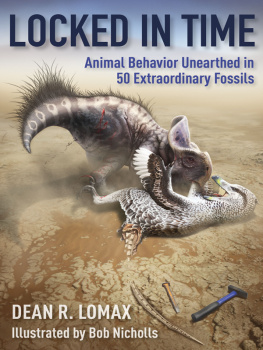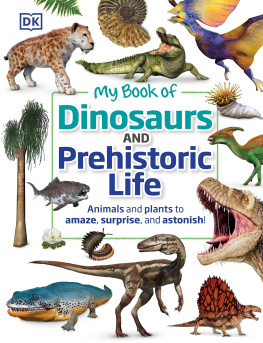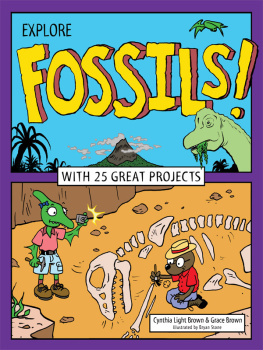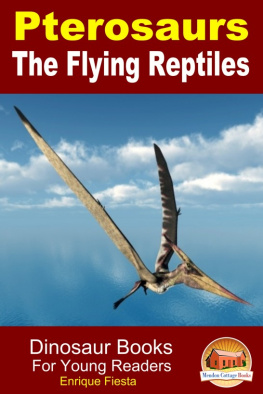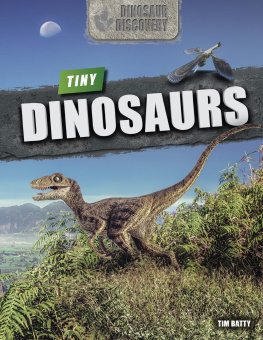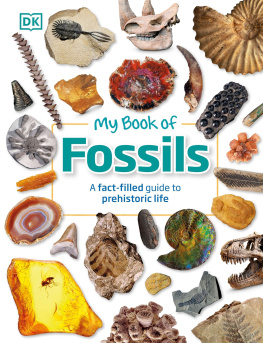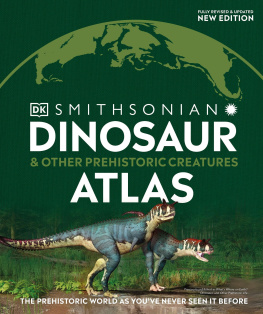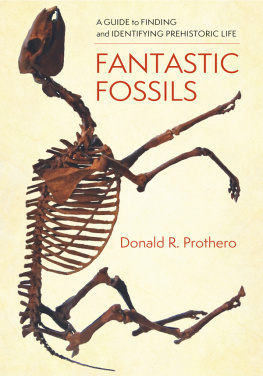Table of Contents
LOCKED in TIME
LOCKED
in TIME
Animal Behavior Unearthed in
50 Extraordinary Fossils
DEAN R. LOMAX
Illustrated by Bob Nicholls
Columbia University Press
New York
Columbia University Press
Publishers Since 1893
New York Chichester, West Sussex
cup.columbia.edu
Text 2021 Dean R. Lomax
Illustrations and photographs 2021 Robert Nicholls
All rights reserved
EISBN 978-0-231-55208-0
Library of Congress Cataloging-in-Publication Data
Names: Lomax, Dean R., author. | Nicholls, Bob, 1975 (Paleoartist), illustrator.
Title: Locked in time: animal behavior unearthed in 50 extraordinary fossils /
Dean R. Lomax; illustrated by Bob Nicholls.
Description: New York: Columbia University Press, [2021] | Includes bibliographical
references and index.
Identifiers: LCCN 2020046670 (print) | LCCN 2020046671 (ebook) |
ISBN 9780231197281 (hardback) | ISBN 9780231552080 (ebook)
Subjects: LCSH: Animals, Fossil. | Animals, FossilBehavior. |
Animal behaviorEvolution.
Classification: LCC QE761 .L66 2021 (print) | LCC QE761 (ebook) |
DDC 560dc23
LC record available at https://lccn.loc.gov/2020046670
LC ebook record available at https://lccn.loc.gov/2020046671
A Columbia University Press E-book.
CUP would be pleased to hear about your reading experience with this e-book at .
Cover design: Milenda Nan Ok Lee
Cover image: Bob Nicholls
Frontispiece: Ray Troll
For my wonderful mum, Anne Lomax.
Thank you for supporting me every step of the way.
Contents
D o you remember the first time you saw a dinosaur skeleton? With your head tilted back, eyes wide open, and experiencing that overwhelming, uncontrollable wow factor? For many of us, coming face to face with an intimidating colossus of bones and teeth, an animal unlike anything alive today, would have filled you with an incredible sense of wonder and excitement.
But have you ever pondered what dinosaurs and other prehistoric animals did in their daily lives? Maybe what they ate or if they got sick? Perhaps how the animals cared for their babies and whether they laid eggs or gave birth to live young? Finding answers to these apparently simple questions is an almighty, complex challenge for paleontologists studying fossils. Some fossils, however, are so remarkable that they record direct evidence of such behaviors, capturing specific moments in the lives of long-extinct species. These are among the most fascinating, awe-inspiring, and exceptional of all fossils ever found.
Rather than just preserving an impression or the remains of an organism, these rarest of all fossils do so much more. They give us a detailed glimpse into how prehistoric animals actually lived. Although somewhat cryptic, such discoveries provide paleontologists with all (or most) of the pieces of the puzzle to reliably interpret what happened to an animal during its life or at the time of its death.
Take, for example, the fact that in practically every dinosaur film or TV show ever made, the climax will inevitably be a prehistoric battle. In reality, only one example of a pair of dinosaurs fighting to the death has ever been described in the scientific literature. (Another pair of apparently dueling dinosaurs has been found but has yet to be formally studied.) This does not mean that fighting was rare in dinosaurs or other prehistoric animals. Rather, it highlights the extreme improbability that such behaviors would be captured in fossils. Consider how slim the chances are that two dinosaurs, dying mid-fight, would be trapped and buried together so they would not just stay intact but then become preserved for eternity, capturing their fight for all time. That paleontologists would then come along millions of years later and discover them still locked in combat is extremely fortunate, especially considering that the fossil could easily have been eroded away and lost forever.
Even though dinosaurs make up only a tiny fraction of what we know about prehistoric life, for many they are the gateway into paleontology and often science in general. In this book, I have included amazing dinosaur fossils that tell unique storiessuch as dinosaur parents caring for young and dinosaurs dealing with disease. I have also taken advantage of exquisite fossils from other animal groups whose tales extend hundreds of millions of years into the past. You will be given a glimpse of the mating rituals of creatures preserved forever mid-sex, uncover a giant shark nursery, capture the magical moment of a seagoing reptile giving birth, and discover many more extraordinary fossils.
The fifty stories I have curated in this book will take you on a global journey through the depths of time. Bringing these exciting real eventsand the animals themselvesto life, Bob Nicholls has created some beautiful illustrations, one for each of the fifty fossils. All of the illustrations are based entirely on the story contained in each fossil. Most important, they are all scientifically accurate, derived from evidence and scientific research as opposed to simple assumptions.
I want to show that fossils are not just inanimate objects. They are time capsules that provide us with an insight into a vanished worlda world that is unrecognizable and yet so familiar all at once. These fossils offer much more than facts and figures; they showcase that behaviors typical of living animals in the present day have their evolutionary origins nestled far back in time. Through the following stories and illustrations, we can see snapshots of moments in time and learn to appreciate that these were once living, breathing animals that were as real as you and me. This is their story, of lives Locked in Time.
Paleontology is going through a golden age of discovery right now. New finds are coming in thick and fast. Whether it is the latest feathered dinosaur with color from Asia, the DNA study of a 12,000-year-old mammal from South America, or the identification of an extinct species of early humans from Africa, the latest and greatest finds pique the interest of many. In todays world, where access to knowledge is at our fingertips, paleontology has never been so openly available.
It is through these types of discoveries and their reports in the media that I became so fascinated with fossils. I was one of those children who absolutely loved dinosaurs and all things prehistoric. You know the typethat annoying kid telling everybody dinosaur facts. Today, I get to do this as my job.
My passion for this project stems from what became a career-defining trip to Wyoming in 2008. This was the first time for me traveling from the UK to the United States; it was also the first time I traveled abroad alone. I was eighteen years old and had sold my Star Wars collection (yes, really!) to fund my first professional excavation and research trip to the Wyoming Dinosaur Center, a wonderful museum in the mythical-sounding town of Thermopolis. On my very first day, I was given a tour of the museum displays, and one incredible fossil caught my eye: a large slab of limestone rock that had tiny footprints tiptoeing across its surface. I followed them and unknowingly found myself retracing the footsteps of a 150-million-year-old death scene.

